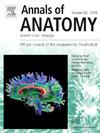胎鼠发育中的舌组织、循环和肝脏中发现的红细胞的比较原位特征。
IF 2
3区 医学
Q2 ANATOMY & MORPHOLOGY
引用次数: 0
摘要
背景:红细胞参与胚胎器官发育和成体组织修复,为组织提供氧气。在小鼠发育过程中,卵黄囊胚外血岛产生的原始红细胞开始作为未成熟和有核的红母细胞循环,在胚胎第9.5天左右开始心脏收缩(E9.5)。另一方面,来自卵黄囊和动脉血管的终代红细胞祖细胞定植在胎儿肝脏中,在那里它们成熟为小的、去核的终代红细胞,在E11.5时释放到循环中。然而,在许多情况下,红细胞也在组织脉管系统发育过程中原位生成。我们假设外周组织造血产生的红细胞的特性可能与同期循环的红细胞不同,因为造血在时空上不同于典型的原始和最终造血。方法:采用免疫荧光法对红细胞和内皮细胞标记蛋白进行染色,在E12.5和E14.5时对发育中的胎鼠舌、循环和肝脏中的红细胞进行原位蛋白表达比较分析。结果:在E12.5时,发育中的舌内分布不规则伸长的未成熟血管内皮细胞,其中许多细胞与有核的红母细胞接触。在检查的三个胎儿部位(舌、循环和肝脏)中,大多数E12.5的红系细胞表达CD31,这参与了细胞间的相互作用;而E14.5下调其表达。有趣的是,在E12.5时,舌头中发现了几个强烈表达CD31的红母细胞,但在循环和胎儿肝脏中含量较少。E12.5胎中几乎所有的红细胞都表达原始红细胞特异性β h1 -球蛋白;然而,那些强烈表达胚胎珠蛋白的细胞是分散的,特别是在舌头上,在循环和胎儿肝脏中较少。相反,在舌中几乎没有发现表达成人β1-珠蛋白的红细胞,这与循环和胎儿肝脏形成鲜明对比,在胚胎期几乎所有红细胞都弱表达β1-珠蛋白。在E14.5时,表达β h1 -球蛋白的细胞数量急剧减少;然而,它在舌头中的含量仍明显高于循环和胎儿肝脏。在所有三个部位,β1-珠蛋白的积累和红细胞的去核在E12.5至E14.5期间均匀而迅速地进行。结论:与循环细胞和胎儿肝脏细胞相比,舌细胞中原始红母细胞表达CD31较高,成熟较慢,被最终红母细胞取代的速度较慢。在发育中的舌头血管形成过程中,原始的红母细胞与未成熟的血管内皮细胞一起产生,可能具有除供氧以外的功能,如调节血管重塑。本文章由计算机程序翻译,如有差异,请以英文原文为准。
Comparative in situ characterization of erythroid cells found throughout the developing tongue tissue, circulation, and liver of fetal mice
Background
Erythroid cells contribute to embryonic organ development and adult tissue repair supplying oxygen to tissues. During mouse development, the primitive erythroid cells produced in the extraembryonic blood islands of the yolk sac begin to circulate as immature and nucleated erythroblasts with the onset of cardiac contractions around embryonic day 9.5 (E9.5). On the other hand, the definitive erythroid progenitors derived from the yolk sac and arterial vessels colonize the fetal liver, where they mature into small, enucleated definitive erythrocytes that are released into circulation at E11.5. In many cases, however, erythroblasts are also generated in situ during the development of tissue vasculature. We hypothesized that the properties of erythroid cells generated by peripheral tissue hematopoiesis may differ from those of contemporaneously circulating erythroid cells because hematopoiesis is spatiotemporally distinct from typical primitive and definitive hematopoiesis.
Methods
Comparative in situ protein expression analyses of erythroid cells in developing tongue, circulation, and liver of fetal mice were performed at E12.5 and E14.5, using immunofluorescence staining of several marker proteins for erythroid and endothelial cells.
Results
At E12.5, irregularly elongated immature vascular endothelial cells, many of which were in contact with nucleated erythroblasts, were distributed in the developing tongue. In the three fetal locations examined (tongue, circulation, and liver), most erythroid cells at E12.5 expressed CD31, which is involved in cell–cell interactions; however, the expression was downregulated by E14.5. Interestingly, at E12.5, several erythroblasts strongly expressing CD31 were found in the tongue, but less abundant in the circulation and fetal liver. Nearly all erythroblasts in E12.5 fetuses expressed primitive erythroid cell-specific βH1-globin; however, those strongly expressing the embryonic globin were scattered, particularly in the tongue, fewer in the circulation and fetal liver. On the contrary, erythroid cells expressing adult β1-globin were scarcely found in the tongue, which is in stark contrast to those in the circulation and fetal liver, where nearly all erythroid cells weakly expressed β1-globin at the embryonic stage. At E14.5, the number of βH1-globin-expressing cells drastically decreased; however, it was still significantly higher in the tongue than in the circulation and fetal liver. In all three locations, β1-globin accumulation and the enucleation of erythroid cells progressed uniformly and rapidly from E12.5 to E14.5.
Conclusion
The results indicate that primitive erythroblasts in the tongue highly express CD31, mature more slowly, and are replaced by definitive erythroid cells more slowly than those in the circulation and fetal liver. Primitive erythroblasts produced together with immature vascular endothelial cells during vasculogenesis in the developing tongue may perform functions other than oxygen supply, such as regulating vascular remodeling.
求助全文
通过发布文献求助,成功后即可免费获取论文全文。
去求助
来源期刊

Annals of Anatomy-Anatomischer Anzeiger
医学-解剖学与形态学
CiteScore
4.40
自引率
22.70%
发文量
137
审稿时长
33 days
期刊介绍:
Annals of Anatomy publish peer reviewed original articles as well as brief review articles. The journal is open to original papers covering a link between anatomy and areas such as
•molecular biology,
•cell biology
•reproductive biology
•immunobiology
•developmental biology, neurobiology
•embryology as well as
•neuroanatomy
•neuroimmunology
•clinical anatomy
•comparative anatomy
•modern imaging techniques
•evolution, and especially also
•aging
 求助内容:
求助内容: 应助结果提醒方式:
应助结果提醒方式:


